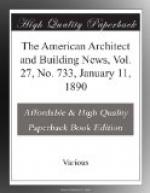An imitation of the tent is found later on in the form of the Chinese and Japanese structures; the principle of the cave appears developed in the subterranean dwellings of the people of India and Nubia; while the hut is the point of departure for all Greek and Roman architecture.
As soon as man had contrived a shelter for himself, before considering improvements that might be made in it, he turned his thoughts toward the divine being of his worship, and the first steps in art were taken in the monuments which he raised to his gods. Then, confounding kings with deities, he reared palaces like unto temples. But civil architecture, properly so called, came into existence only with an already advanced state of civilization, when cities were forming and peoples were organizing. After having satisfied the demands of the moral nature, after having erected temples to their gods and palaces to their kings, the people began to group together and surround themselves with fortifications. Next the material needs of society made themselves felt; aqueducts were constructed to supply water; bridges established communication between the opposite banks of streams; dikes confined the rivers within certain bounds; streets were laid out along which houses were built in orderly fashion, public squares were marked off where the products of industry could be exchanged, where justice was dispensed and where the great affairs of State were treated; then came mental and physical demands, a felt need for the training of body and mind, and out of this want grew theatres, stadia, gymnasia and thermae. In time we find the history of a single people developing; and with this development a necessity arising for lasting monuments to commemorate its various stages; public services rendered by certain illustrious men called for some enduring memorial; and relatives and friends, with whom one had lived and whom the dread enemy had snatched away could not be left without sepulture. Is there nothing after death? And so honorary monuments, triumphal columns, statues and tombs sprang into being. Again, with the growth of a people, wealth increases, and every new victory assuring an added degree of ease introduces at the same time extravagant tastes; a people after enduring suffering cries out for its portion of pleasure; it was to satisfy this demand that circuses were built, and amphitheatres where the eyes could feast on imposing spectacles; private houses became more comfortable, they were improved in arrangement, they were enlarged and embellished; at length an extraordinary display of sumptuousness began to appear in the dwellings of the great,—that luxury of decadence which marks the close of ancient civilization.




